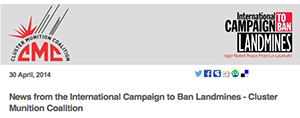01 September 2010
CMC intervention at the CCW Group of Governmental Experts
The Broken Chair sculpture stands outside the UN Palais des Nations in Geneva as a symbol against landmines and cluster munitions. Photo credit: Handicap International(Geneva, 1 September 2010) - Following the introduction of a draft protocol on cluster munitions to the Convention on Conventional Weapons' Group of Governmental Experts on 31 August, the Cluster Munition Coalition intervened to express concerns about the draft’s significant failures to provide an urgent response to the issue of cluster munitions, be compatible with the Convention on Cluster Munitions, or contain meaningful provisions.Below is the full text of the intervention by CMC Coordinator Thomas Nash.Remarks by Thomas Nash on behalf of the Cluster Munition CoalitionCCW Group of Governmental Experts on Cluster MunitionsGeneva, Wednesday 1 September 2010Thank you Mr Chairperson and thank you for your openness and cooperation with non-governmental organisations.We believe that with the entry into force of Convention on Cluster Munitions exactly one month ago today, means we are in a new situation with regard to deliberations at the CCW on cluster munitions. We’d like to take this opportunity to congratulate all states that have signed and ratified the Convention on Cluster Munitions. This entry into force is remarkably swift and reflects what the UN Secretary General has described as the "world’s collective revulsion" at this weapon. The UN Secretary General has convened the First Meeting of States Parties to be held in Lao PDR and preparations are going well for that.We need to face the reality that two thirds of CCW states have signed or ratified CCM. These states have a legal obligation to promote the norms established by the Convention on Cluster Munitions. It will be very difficult for a protocol that directly conflicts with the standard of Convention on Cluster Munitions to emerge from such a group of states.The Convention on Cluster Munitions is emerging as the clear global standard on cluster munitions and we are confident the stigmatisation of the weapon will continue to deepen. However, we share the concern that others, including the ICRC have raised with regard to the negative development of IHL. This is a very serious concern. The CCW was not established in order to weaken existing IHL – quite the contrary.Many have noted that this exercise is positive the main users and producers are here. However there are other ways to maintain a dialogue between all countries that have used, produced and stockpiled cluster munitions and those who are affected, whether they have joined the Convention on Cluster Munitions or not. Indeed a number of positive engagements are happening on a bilateral, regional and multilateral basis between States Parties to the Convention on Cluster Munitions and states outside the CCM and these should continue.In line with your guidance, we will not provide detailed remarks at this stage, but we can give an initial reaction. In orienting themselves to discussions in this framework, many delegations have expressed fundamental concerns that any new protocol should provide an urgent response, should be compatible with the Convention on Cluster Munitions and should have meaningful provisions. We believe this new text fails on all three concerns.Regarding urgency: the text allows for an eight year transition period plus a possible four year extension, plus the time it takes for countries to consent to be bound by the Protocol. This is not an immediate or even urgent response.Regarding compatibility: the Convention on Cluster Munitions is an immediate and comprehensive prohibition. This text allows for unrestricted and indefinite use, production and transfer of a range of cluster munitions. The draft does not address the issue of the area effect of cluster munitions during attacks, which CCM states took as a key reason to prohibit the weapons. So it is clearly not compatible.Regarding meaningful provisions: We know that this text is not going to provide a framework to put an end to the suffering caused by cluster munitions and to eradicate them completely. It is also difficult to assess the level to which these provisions might be meaningful because we don’t know what they mean in practice for the differing states and their national stockpiles. In some ways it appears almost like the provisions are deliberately vague and open to interpretation in order to allow countries to maintain use, production and transfer based on their own existing and potential needs for such actions. This is not a basis for an international agreement.We understand the points raised by delegations this morning about not ‘wasting’ the deliberations that have gone on here over the past few years and it is positive that all states are here discussing the need to respond to the humanitarian problem of cluster munitions. While a new protocol may not emerge, we could still find ways to secure the measures that certain states have indicated they can pursue, such as prohibiting the transfer of certain cluster munitions immediately or committing to end use and to destroy cluster munitions by a certain date. All such measures can represent positive forward steps from countries on a national basis, but not as a basis for new agreements that contradict existing IHL. On this basis we see no justification for continued work in this format.So while there is no humanitarian benefit in adopting a protocol based on this text, there will be a political cost of agreeing a new lower standard. Externally, this will inevitably be portrayed as a backwards step that is providing a blueprint for future use, production and transfer of a weapon that most UN member states have agreed to ban outright.Thank you Mr. Chairperson.


